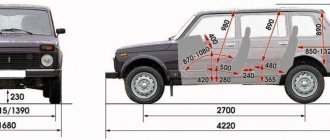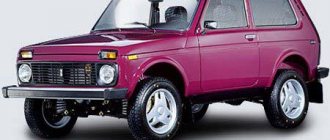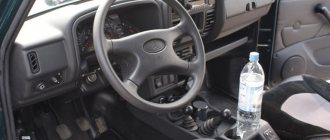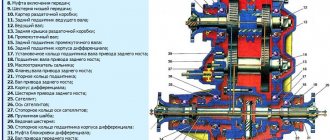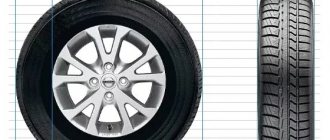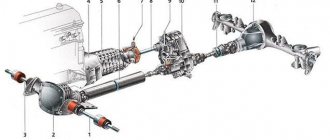One of the most interesting and respected creations of the domestic automobile industry is the Niva car.
This Soviet and then Russian SUV was highly popular and was even exported to other countries of the world. Based on it, a considerable number of modifications were created, many of which are little-known, but very interesting. The first Niva rolled off the assembly line in 1977 and immediately won the hearts of motorists. Under the hood was an in-line engine with a capacity of 80 horsepower per 1.6 liter. It was equipped with a four-speed gearbox. Slightly different models were sent for import - with a 1.3-liter engine.
Lada Niva iKRA
In most cases, visible changes are made during modification. This was the case with an SUV called Lada Niva iKRA. These cars were produced for a short time from 1993 to 1995, and they were supplied to the Spanish automobile market. To attract foreign buyers, it was decided to make the car’s interior more comfortable and use a bright body kit.
VAZ-2121 Niva
“Six” instruments today cannot be considered the standard of information content - the arrows sometimes deviate to the side when cornering or when braking.
But this toolkit looks great. “Six” instruments today cannot be considered the standard of information content - the arrows sometimes deviate to the side when cornering or when braking. But this toolkit looks great.
Lada Niva Special
This is a modification of a classic SUV, created by the Czech company Autolada CZ. The cars were modified in Prague in very small batches. The masters modified the classic version by extending the rear protrusion and installing wings. You could buy such a car in the Czech Republic and Slovakia. Interestingly, the buyer could choose a cargo version called Praktik, which had only two seats and a simple passenger version.
Deutsche Lada Niva Cabrio
German masters were interested in changing the Soviet Niva. So in 1983, based on this SUV, Deutsche Lada Automobil GmbH, which was the official importer of these cars, introduced a convertible, which completely lacked side pillars and roof strength elements. But a tubular frame appeared, with which they decided to strengthen the body.
The new version has front seats with head restraints, enhanced lateral seat support and seat belts. Additionally, plastic fender extensions were used, which were painted in the color of the car and gave it a more impressive look.
VAZ-2121 Niva
The high side makes loading heavy items difficult.
But before, the trunk could be opened from the outside, whereas a modern car allows you to do this only from the interior. The high side makes loading heavy items difficult. But before, the trunk could be opened from the outside, whereas a modern car allows you to do this only from the interior.
VAZ-21213 “Laura”
NIVA Laura is an armored car with hinged doors, based on hidden armor technology. The car was intended mainly for collectors, but could also be used for other purposes. Full-length curved glass provided the crew with a high degree of visibility, and hinged doors made it possible to quickly load or unload crew and valuables.
VAZ-2121 Niva
The interior of the Niva in the first years of production looks more interesting than the current version.
Instruments in individual wells, large signal lamps with chrome frames. Plus a Soviet “fetish” in the form of a steering wheel braid and gearbox knob with a rosette. The interior of the Niva in the first years of production looks more interesting than the current version. Instruments in individual wells, large signal lamps with chrome frames. Plus a Soviet “fetish” in the form of a steering wheel braid and gearbox knob with a rosette.
Bronto-212182 "Force"
Niva cars are often used as a basis for creating unusual modifications. One of the interesting solutions is an armored vehicle, called “Force”, in which the armor and glass are capable of withstanding a 5.45 mm Kalashnikov burst. and 7.62 mm. This model was developed for collectors. Additionally, it was equipped with an air conditioner, another battery, and a fire and explosion-proof fuel tank.
Bronto-212183 "Landole"
This model was also presented. The classic Niva has been greatly modified. The upper part of the body was completely removed and a safety cage was installed in its place. The doors were completely removed, and small plastic stops appeared instead. The usual trunk is also missing here, which has been replaced by an open side. This model was produced in 1998-2009.
Bronto-1922-55 "Marsh-Combi"
This is a newly modified Niva car, which was transformed by specialists from Bronto. The basis of the transport was the bridges and frame of the UAZ-3151, but the body was used from the VAZ-21213. The first thing that catches your eye is the huge pneumatic wheels, which allow this vehicle to move on low-traffic soils, which is where the name “March” comes from, meaning “swamp” in French. The gearbox, engine and transfer case still remain from the Niva in this seriously updated SUV.
How the legend was created: the history of Niva
In April of this year, the Lada 4X4 celebrates its anniversary: for 40 years now, the model, periodically modernized, has been on the assembly line. Paying tribute to this legendary car, let's remember the main milestones of its history
Editorial
It all started back in 1970, when Chairman of the Council of Ministers of the USSR Alexey Kosygin, as part of the program “blurring the line between city and countryside,” set the teams of VAZ, AZLK and Izhmash the task of creating a comfortable SUV for residents of rural areas.
This is how the VAZ-2121 changed in the process of developing the design and improving the design
The first experimental VAZ-E2121 saw the light of day in 1971. Moreover, his appearance was very far from what we have become accustomed to for forty years. In fact, it was a chassis with a simple tail, on which the concept of a new car was developed - the SUV did not have a frame, which at that time was considered an unheard-of design audacity. Initially, the car was planned to be equipped with a powerful diesel engine, final drives, rear torsion bar suspension and even a tire pressure regulation system, but later they decided to create a simpler version with a high degree of unification with the models already produced by AvtoVAZ, which was economically justified. This prototype allowed the design bureau under the leadership of Peter Prusov to significantly reduce the time needed to create the car. Is a 1.6-liter engine enough, is the gearbox reliable enough, does the car require a center differential lock and downshifts? The answers to all these questions were obtained thanks to the VAZ-E2121. It is interesting that the tests of the car were carried out in the strictest secrecy, and when asked by those interested, the factory workers answered that they were testing a new Romanian SUV.
The VAZ-2121 appeared in a form close to the serial one in 1972. The artist Valery Semushkin worked on the design of the new car. The car, according to the designer’s plan, was supposed to suit residents of both cities and villages. Both a collective farmer transporting his produce to the city market and a worker who decided to go out into the forest to pick mushrooms should feel equally comfortable in it. And since, according to the technical specifications, the car was supposed to have a relatively small trunk, the spare tire, in order to save space, was placed in the engine compartment. At that time, placing the spare wheel on a remote bracket behind the rear door was considered unsightly. In 1973, the VAZ-2E2121, which looked almost like the well-known Niva, was sent on a test run across Central Asia, after which it acquired a headlight cleaner and a rear wiper. An ahometer appeared on the instrument panel, which allowed the driver to monitor the speed when driving in the downshift range of the transmission. In 1974, the car was put up for state tests and in the same year received its own name “Niva”, which was patented. It is interesting that at that time there was no GOST for testing this type of car. After all, the standard testing scheme for SUVs for the Niva was too harsh, but for passenger cars it was the opposite... In the end, they decided to combine both programs, taking into account the versatility of the car. Based on the test results, the car received recommendations for mass production and export. True, before being put on the assembly line, the car received some more improvements. So, the rear “three” lights were replaced with “six” ones, and the headlights were taken from the “six”. The chrome bumper gave way to an aluminum one. A second outside rear view mirror has appeared. The first pilot batch of 50 vehicles was sent to the regions for controlled operation. Representatives of the plant constantly supervised their new product, which made it possible to identify several more “sores”, which were eliminated by April 1977, and the Niva entered the assembly line.
In addition to sales at home, Niva was actively promoted in foreign markets. Over forty years, more than 500 thousand SUVs were sent abroad. This unpretentious, but at the same time quite comfortable SUV has attracted buyers in more than 100 countries around the world. Importers actively re-equipped the car, making it into pickup trucks, convertibles, and styling it according to fashion. In addition, assembly of the model was established in Brazil, Greece, Canada, Panama, Chile, and Ecuador. The Niva was even exported to Japan, becoming the only Soviet car officially sold in this country. By the way, the Japanese, paying tribute to the general designer of Niva, gave Pyotr Prusov in 1986 an advertising brochure for their future Suzuki Vitara with the inscription “To the Godfather of this car.”
In 1978, the VAZ-2121 was awarded a gold medal and recognized as the best car of its class at the international exhibition in Brno. “Niva” has a lot of records. So, in 1998, Niva climbed Mount Everest under its own power, to a height of 5200 meters, in the same year, being dropped by parachute, it ended up in the Arctic and reached the North Pole under its own power, and the next year climbed to the Himalayas to a height of 7260 meters. She also visited Fuji. The reliability of the car is also evidenced by the fact that the production car was able to operate without serious breakdowns for 15 years in Antarctica at the Bellingshausen station. And this is in the complete absence of roads. Niva has a lot of sporting achievements to its credit: multiple participation in the Paris-Dakar rally, Atlas rally, Cameroon Rally and other achievements.
In 2001, the history of the VAZ-2121 as a Niva ended. The holder of the exclusive license for the Niva trademark was the GM-AvtoVAZ joint venture. But the history of the car itself continued and continues under the name LADA 4X4.
1998. “Niva” visited both Antarctica (1990) and the North Pole (1998), more than once conquered peaks under its own power and won victories in marathon rallies
1999. In 1999, "Niva" rose to a height of 5726 m in the mountains of Tibet. Before this, wheeled vehicles never rose to such a height under their own power.
Importers advertised the VAZ-2121 in every possible way in their periodicals; in addition, some of them allowed themselves to adapt the car to their markets through modifications
FOR 40 YEARS, THE LADA 4X4 HAS BEEN ON THE CONVEYOR OF THE VOLGA AUTO GIANT. MANY THINK THAT SHE HAS NOT CHANGED AT ALL DURING THIS TIME. WELL, WE HOPE TO DISCONCEIVE YOU ABOUT THIS. AND HERE WE WILL ONLY GIVE THE MOST NOTICEABLE CHANGES. IF WE'RE TALKING ABOUT SMALL MODERNIZATION, THERE WAS SO MUCH OF IT DURING THIS TIME THAT IT WOULD BE ENOUGH FOR MORE THAN ONE ARTICLE.
APRIL 5, 1977
Assembly of the first production car VAZ-2121 Niva.
1980
Start of production of an export modification of the VAZ-21212 with right-hand drive. The car was produced in limited quantities, primarily for the English market. The vehicles were also supplied to Australia, New Zealand, Mozambique, Japan and Jamaica.
1985
State tests of the floating modification of the Niva - VAZ-2122 (Project "River") have been completed. The State Commission recommended the car for production. The car was positioned as an army SUV for a company commander, but in an open document flow.
1990
Start of production of modification with engine 21214 with central fuel injection. The majority of changes to the engine design are associated with the transition to an injection system, the introduction of elements that ensure compliance with Euro-2 environmental standards and the use of hydraulic compensators. Installing power steering on a car required additional modifications to the engine components.
1993
Start of production of a modification of the VAZ-21213 with a 1.7 liter engine, 5-speed gearbox, updated interior and modernized body. In particular, the third door has been enlarged, which has significantly reduced the loading height. The car also received new lighting equipment.
1995
Start of production of the VAZ-21215 modification with the Peugeot XUD9 diesel engine. It was produced in small series for export, so the package included other bumpers, spoilers, linings, alloy wheels, etc.
1995
The production of VAZ-2131 cars with an extended wheelbase and a five-door body has begun in the AvtoVAZ pilot production facility.
1996
Production of a three-door modification of the VAZ212180 “Fora”, extended by 300 mm, has begun.
1997
The production of VAZ-2329 pickups based on the VAZ-2131 has begun in the pilot production of AvtoVAZ. The vehicle's carrying capacity is 4 people and 350 kg of cargo.
2011
Launch of modifications of the VAZ-21214 with ABS and BAS. The car is partially unified with Niva-Chevrolet. In particular, a new Valeo clutch was installed on it. As a result, the resource of this unit has doubled, and the car itself has become less susceptible to vibration due to a reinforced damper spring and an enlarged disk.
2013
In accordance with the law, daytime running lights in the headlights have been installed on all Lada 4x4 vehicles. Cataphoresis primer and metallic painting have been introduced with a guarantee against through body corrosion for up to 6 years.
2014
In the intermediate shaft, the cardan cross was replaced with a CV joint, which reduced vibrations emanating from the transmission and significantly improved the comfort of the car. A new vacuum brake booster of increased size was introduced - from 8 to 9 inches, a new main brake cylinder with a diameter of 22.22 mm was used instead of 20.64. The result of the modernization was the reliability and durability of the brake system, and the mileage before changing the brake pads increased. The dimension of the shock absorbers was increased, the length and damping characteristics were optimized, which made it possible to increase the dynamic energy intensity of the suspension, the suspension travel from 150 to 170 mm, significantly reduce the galloping effect of the car, and increase the service life of the shock absorbers.
2014
Production of the VAZ-21214 “Urban” configuration has begun with a modified appearance (bumpers, radiator grille), electrical package, air conditioning system and electrically heated seats. The length of the windshield wiper blades has been increased from 330 to 410 mm (the windshield cleaning area has been expanded). Double-jet windshield washer jets have been used (increased washer efficiency).
2016
A transition to Euro 5+ toxicity standards has been carried out, and a modernized hub unit with non-adjustable bearings has been introduced. As standard, cars are equipped with electric windows and ABS. Changes were made to the design of the front axle: it was disconnected from the engine and installed on the front suspension. This decision has led to a reduction in vibrations, which allows, if necessary, to install another (new) power unit on the car.
LADA 4×4: 40 years of achievements
The editors recommend:
Quiz!
Blackvue DVR for knowledge of traffic rules Alternative to a scraper: how to clean car windows without scratching them
Hyundai Elantra or Skoda Octavia: what to choose? We compared and were surprised
3 million is not a luxury: transport tax in Russia will be calculated in a new way
Which cars do dealers make the biggest markups on: list
News Media2


